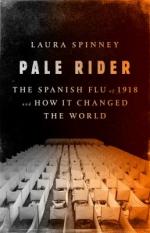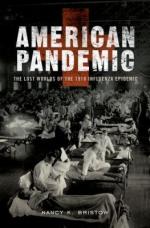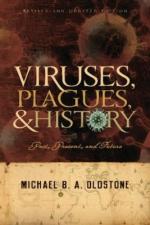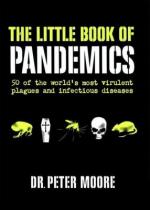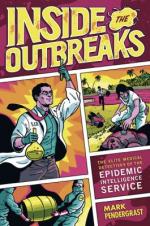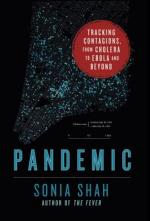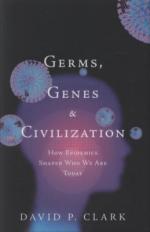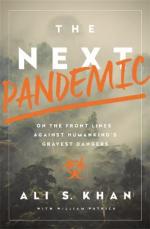January 27, 2018 | sobczakd
This year marks the 100th anniversary of one of the most devastating global disasters in world history, the Flu Pandemic of 1918. During the fall of the Great War in 1918, an extremely virulent strain of influenza began to spread worldwide. The H1N1 influenza virus also known as the Spanish Flu caused such widespread outbreaks that it killed one fifth of the world's population. This year's influenza strain, the H3N2, is not a new strain, but it's one of the most lethal. Already it has affected every state in the U.S. and is on track for surpassing previous flu seasonal records. What to learn more about viruses? Check out this list!
The history of "the greatest massacre of the twentieth century," an illness that infected more than 500 million people.Between 1918 and 1920, the "Spanish flu" killed more than 50 million people, far more than in the world war then raging. Unlike the familiar flu, which targets infants and the elderly, it killed healthy adults. It was mankind's worst epidemic, writes Paris-based science journalist and novelist Spinney (The Quick, 2007, etc.) in this fine account of influenza's history, its worst attack (so far), and its ominous future. Despite the name, Americans were probably the first to experience the fever, cough, headache, and general miseries of the infection. During spring and summer, it behaved like the usual flu, but in fall 1918, it turned deadly and spread across the world, killing 2.5 to 10 percent of victims, a fatality rate 20 times higher than normal. Scientists have offered countless theories about the illness, but Spinney looks favorably at a recent theory that the 1918 virus provoked a "cytokine storm," a deadly overreaction of the immune system. This may explain why infants and the elderly, with their weaker immune systems, had an easier time. In the middle sections of the book, the author describes how a dozen nations dealt with the epidemic. Heroism was not in short supply, but superstition, racism, ignorance (including among doctors), and politics usually prevailed. In the concluding section, Spinney recounts impressive scientific progress over the past century but no breakthroughs. Revealing the entire viral genome opens many possibilities, but so far none have emerged. Researchers are working to improve today's only modestly protective vaccine; Spinney expresses hope. Readers who worry about Ebola, Zika, or SARS should understand that epidemiologists agree that a recurrence of the 1918 virus would be worse. Short on optimism but a compelling, expert account of a half-forgotten historical catastrophe.
The author unpacks the complex cultural, social and scientific effects of the 1918 influenza epidemic and reveals the American voices that fill the gap of a suppressed national memory. In less than two years, influenza killed more than 50 million people worldwide, shocking existing medical infrastructures and destabilizing the trust that citizens had in science. Physicians were at a loss to prescribe effective treatments; racial and gender divides grew as misunderstandings about the spread of disease exacerbated existing stereotypes; and fear of contagion threatened to collapse the kind of community support that had helped the nation endure past hardships. Simultaneously, the rise of public health care employed the rhetoric of opportunity and optimism, further destabilizing social boundaries as the death rate climbed. A combination of media emphasis on looking toward the future and a public call for increased funding for new scientific research assisted in whitewashing the deep sense of loss and despair that afflicted most Americans as they dealt with the aftermath of the pandemic. Bristow, whose great-grandparents succumbed to influenza in 1920, writes with depth and feeling. By researching dozens of primary sources, she reveals the human circumstances and personal stories behind the history of this tragic era. It's a much-needed addendum to pandemic literature and an important perspective to understand as new and ever-evolving flu strains hover over our collective understanding of disease.
The story of viruses and humanity is a story of fear and ignorance, of grief and heartbreak, and of great bravery and sacrifice. Michael Oldstone tells all these stories as he illuminates the history of the devastating diseases that have tormented humanity, focusing mostly on the most famous viruses. Oldstone begins with smallpox, polio, and measles. Nearly 300 million people were killed by smallpox in this century alone and the author presents a vivid account of the long campaign to eradicate this lethal killer. Oldstone then describes the fascinating viruses that have captured headlines in more recent years: Ebola, Hanta virus, mad cow disease (a frightening illness made worse by government mishandling and secrecy), and, of course, AIDS. And he tells us of the many scientists watching and waiting even now for the next great plague, monitoring influenza strains to see whether the deadly variant from 1918--a viral strain that killed over 20 million people in 1918-1919--will make a comeback. For this revised edition, Oldstone includes discussions of new viruses like SARS, bird flu, virally caused cancers, chronic wasting disease, and West Nile, and will fully update the original text with new findings on particular viruses. Viruses, Plagues, and History paints a sweeping portrait of humanity's long-standing conflict with our unseen viral enemies. Oldstone's book is a vivid history of a fascinating field, and a highly reliable dispatch from an eminent researcher on the front line of this ongoing campaign.
In September of 1918, soldiers at an army base near Boston suddenly began to die. Doctors found the victims' lungs filled with fluid and strangely blue. They identified the cause of death as influenza, but it was unlike any strain ever seen. It would become the worst epidemic in American history, killing over 600,000- more than all the nation's combat deaths this century combined. Drawing on remarkable archival photographs and film footage, and interviews with survivers and medical historians, INFLUENZA 1918 tells the powerful story of America's worst health crisis. Despite recent triumphs over many infectious diseases, medical science proved powerless against the killer virus. In desperation, people turned to folk remedies: garlic, camphor balls, sugar cubes soaked with kerosene. Frantic officials closed schools, factories and churches, and everyone was required to wear a mask. But the virus was unstoppable. Relentless. Lethal. Curiously, this painful event has nearly faded from our national memory. But as gripping medical thriller proves, it is a story that deserves never to be forgotten.
This fascinating program explores the flu pandemic that swept across the globe in 1918 and killed some 40 million people, four times the number of casualties from the recently ended World War I. As contemporary virologists and epidemiologists continue their research in an effort to understand where this flu strain originated and what made it so lethal, experts predict we will face a comparable pandemic soon, possibly in the next decade.
he three greatest killers in human history have not been war, famine or natural disaster. They have been influenza, Black Death and AIDS. In the face of Avian Flu,The Little Book of Pandemics asks, how anxious should you be? Should you be keeping an eye out for tell-tale discharge? Should you flinch at every cough and itch? Is that headache really just a headache? And what will happen if you do succumb? In May 2005, scientists urgently called nations to prepare for a global influenza pandemic that may hit up to 20 percent of the world`s population. But just how worried should we be and how far has medical science evolved to contain all the threats that surround us? From rashes, tremors, nausea, fever, dizziness, swelling, fainting, bleeding, spasms, blindness, shock, coma and death, here is a fascinating insight into 50 of the most virulent and vicious plagues, pandemics and infectious diseases currently known to medical science.
Plucky epidemiologists track the world's ailments in this hectic public health saga. Pendergrast (For God, Country and Coca-Cola) chronicles the exploits of the doctors, nurses, statisticians, and sociologists of the Centers for Disease Control's Epidemic Intelligence Service, who jet around investigating the causes and remedies of disease outbreaks from Alabama to Zaire. Looming large is the ever-present, life-threatening problem of diarrhea, whose outbreaks they trace variously to contaminated water, iffy tofu, and Oregon cultists who in 1984 sprinkled salmonella into restaurant salad bars. The investigators also take on more exotic cases, including Ebola outbreaks, the post-9/11 anthrax letters, and a grade-school itching epidemic that turned out to be mass hysteria. These epidemiologists have also led long campaigns to eradicate smallpox-in Pendergrast's telling, an epic struggle against both germs and cultural prejudices-and tried to abate social ills like smoking, obesity, and gun violence. There's not much story-telling frippery in Pendergrast's episodic six-decade narrative, just bare-bones accounts of barely individuated sleuths busting one microbial perp after another by collecting samples and conducting surveys. Still the scientific fight against these cunning, deadly pathogens makes for an often engrossing browse.
In this absorbing, complex, and ominous look at the dangers posed by pathogens in our daily lives, science journalist Shah (The Fever) cautions that there are no easy solutions. Of particular note is the challenge of tracking those pathogens that remain uncontained and which could overtake humans in a pandemic. As an example, Shah tracks the waterborne Vibrio cholerae bacterium from its home in the southwest Indian Ocean as it radiated from China and India to Paris in 1832, and then sailed to the U.S. with emigrants from cholera-plagued Europe heading to the eastern coast of North America-at the time there were 5,800 reported cases and nearly 3,000 deaths in New York City alone. Shah then meticulously dissects the conditions that made cholera's transmission so effective and new outbreaks inevitable, including filthy water, overcrowding, political corruption and inaction, scapegoating, and even the expedited expansion of the human population by the harnessing of fossil fuels. "For most of our history, we've been unaware of pathogens' role in our lives," Shah writes, adding that most of the challenges still lay ahead. Shah's warning is certainly troubling, and this important medical and social history is worthy of attention-and action.
Clark (Molecular Biology Made Simple and Fun) argues that microscopic bacteria, viruses, and fungi have played an enormous and largely unacknowledged role in human history. Beginning with Attila's attack of Rome, which was likely stopped by dysentery, and continuing through modern diseases such as AIDS and the Ebola virus, Clark investigates a large number of illnesses and uncovers the ways in which they have impacted historical events. The same genes that provide humanity with protection against some endemic diseases, Clark argues, may also cause sickle cell anemia and cystic fibrosis. With wit and humor, the author turns death, an ever-heavy topic, into an engrossing exploration of the course of mankind. Though Clark's lack of references will make it difficult for readers to gain additional information, there's much of interest in this chronicle of microbes through the ages.
Autobiography of a self-described disease detective whose adventures in public health dramatize the need to modify our approach to emerging infections and possible pandemics.For more than two decades, Khan (Dean, Coll. of Public Health/Univ. of Nebraska), the former director of the Office of Public Health Preparedness and Response at the Centers for Disease Control and Prevention, has dealt with high-profile emergencies at home and abroad. His work as a first responder has taken him from hurricane-devastated New Orleans to the pox-ridden jungles of Zaire, from the hantavirus-infected Four Corners region of the American Southwest to anthrax-contaminated Washington, D.C. While he cites influenza, a highly communicable disease with the capacity to kill millions, as the likeliest cause of a global pandemic, his stories also feature bioterrorism, natural disasters, and viruses such as the ones that caused Severe Acute Respiratory Syndrome (SARS), Middle East Respiratory Syndrome (MERS), Ebola, Rift Valley Fever, West Nile Fever, and even bubonic plague. Khan excels at writing for general readers. Not only does he describe the effects of specific diseases and how he investigates an outbreak and creates a plan to stop it, but he also creates vivid pictures of the setting, the people, and often the politics involved in diagnosis and treatment. The author asserts that we can mitigate, if not prevent, most outbreaks, but only if public health systems are supported in every country and globally through the creation of a United Nations undersecretary for health security. In the final chapter, Khan outlines some of the changes he believes are necessary to move from an emergency response approach to one that emphasizes preparedness and prevention. As he writes, "we cannot excuse infections as simple public health misadventures."
